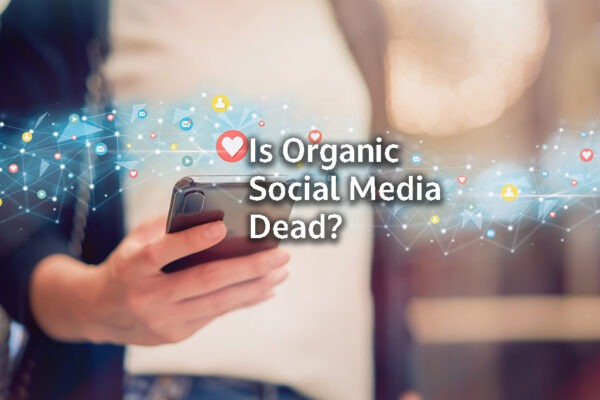Is organic social media dead?

Filters
Results
Organic Social Media in 2025: The Pay-to-Play Era
For years, organic social media has been a ‘go to’ for so many businesses. Businesses could post content, engage with their audience, and grow their brand—without spending a cent. However, in in recent time and especially now in 2025, the reality is clear: organic reach is declining, and paid social media is now the best way to see real returns.
This shift doesn’t mean organic social media is completely dead. Instead, it has taken on a new role—one that supports, rather than drives, social media success. Algorithms now favour paid content, competition for visibility is tougher than ever, and businesses relying solely on organic efforts are struggling to keep up.
So, does this mean you should give up on organic social media altogether? Not necessarily. While organic still has its place, a pay-to-play model is now essential for businesses looking to grow effectively.
The Decline of Organic Social Media
Not long ago, businesses could post on Facebook or Instagram and reach a significant portion of their followers for free. Yet, over time, platforms have adjusted their algorithms to prioritise paid content over organic posts. There are several reasons for this:
- Social Media Is a Business – Platforms like Facebook, Instagram, and LinkedIn rely on ad revenue. As a result, they restrict organic reach to encourage businesses to invest in paid promotion.
- Algorithm Changes Favour Paid Content – Organic posts now reach less than 5% of followers on many platforms. Even highly engaging content struggles to gain traction without paid support.
- Increasing Competition – More brands than ever are fighting for attention. Consequently, without paid promotion, even well-crafted content often gets lost in a crowded digital space.
Ultimately, businesses that depend solely on organic strategies will find it harder to reach their audience. If you want your content to be seen, you need to pay for it.
Why Paid Social Media Wins in 2025
Paid social media isn’t just a necessary expense—it’s a powerful tool that offers better targeting, higher engagement, and measurable returns. Here’s why investing in paid ads is now essential:
1. Guaranteed Visibility
Unlike organic posts, which are subject to unpredictable algorithm changes, paid social guarantees that your content reaches the right audience. In particular, advanced targeting allows businesses to focus on:
- Demographics (age, gender, location)
- Interests (hobbies, lifestyle, behaviours)
- Purchase Intent (retargeting previous visitors, creating lookalike audiences)
2. Higher Engagement and Conversions
While organic content may generate some engagement, paid social ensures that your message reaches users who are ready to take action. Whether your goal is website traffic, lead generation, or direct sales, paid ads deliver faster and more predictable results.

3. Scalability and Predictability
Unlike organic reach, which fluctuates based on algorithm changes, paid social provides measurable performance data. This means businesses can track ROI, optimise campaigns, and scale successful ads while reducing wasted ad spend.
4. More Control Over Audience Targeting
Unlike traditional advertising—such as billboards or TV ads—paid social allows precise audience targeting. Instead of broadcasting content to a broad audience, brands can focus on highly relevant users, ensuring a much better return on investment.
Does Organic Social Media Still Matter?
Yes—but it now serves a supporting role rather than a primary growth driver. Here’s where organic still adds value:
1. Building Community and Engagement
Paid ads drive visibility, but organic content helps maintain relationships. By engaging with followers, responding to comments, and sharing valuable insights, brands can foster trust and loyalty.
2. Establishing Brand Credibility
Potential customers often check a brand’s social media before making a purchase. Consequently, a well-maintained profile with consistent, quality content adds legitimacy—even if it doesn’t directly generate sales.
3. Supporting Paid Efforts
Organic social makes paid ads more effective. When users see active, engaging content on your page, they are more likely to trust and interact with your paid promotions.
How to Balance Organic and Paid Social in 2025
For the best results, businesses should integrate both organic and paid strategies. Here’s how:
1. Prioritise Paid Ads for Growth
Paid ads are most effective for:
- Increasing website traffic
- Generating leads
- Driving conversions and sales
- Promoting new products or services
2. Use Organic Social for Engagement and Retention
Organic content works well for:
- Fostering community engagement
- Showcasing brand personality
- Sharing behind-the-scenes content
- Providing customer support
3. Optimise Paid Ads Based on Organic Insights
Your organic content can serve as a testing ground. If a post performs well organically, consider amplifying it with paid promotion for even better results.
4. Leverage Retargeting for Maximum Impact
A smart paid strategy includes retargeting users who engage with organic content. If someone watches your video or interacts with a post, you can serve them targeted ads to move them further down the sales funnel.
The Future of Social Media Marketing
As social media continues to evolve, businesses must adapt to stay ahead. The days of relying solely on organic content are over. Today, paid social is the most effective way to ensure visibility, engagement, and conversions. However, it’s also important to remember that social media itself is not a strategy—it’s simply a form of media, like Google Ads, TV, radio, or print. What truly matters is how you use it within your broader marketing strategy to drive measurable business results.
That said, organic social media still plays an important role—just not in the way it once did. Instead of driving growth, it now serves as a credibility and engagement tool. The best approach is to combine organic authenticity with the targeting power of paid ads, ensuring that your social efforts contribute meaningfully to your overall marketing goals.
Key Takeaways:
- Organic reach is declining—algorithms favour paid content.
- Paid social guarantees visibility, engagement, and ROI.
- Organic still matters for brand credibility and community-building.
- A winning strategy combines both organic and paid efforts.
- In 2025, social media is pay-to-play. Businesses that embrace paid advertising will see the best results, while those relying on organic alone will continue to struggle.
So, is your social media strategy future-proof? Now is the time to invest in paid social and unlock the full potential of your digital marketing efforts.
Final Thoughts on Organic Social Media
By integrating organic engagement with a strong paid strategy, businesses can build a social media presence that not only grows but converts. Are you ready to shift your approach? If so, start leveraging paid ads today—and watch your results skyrocket.




